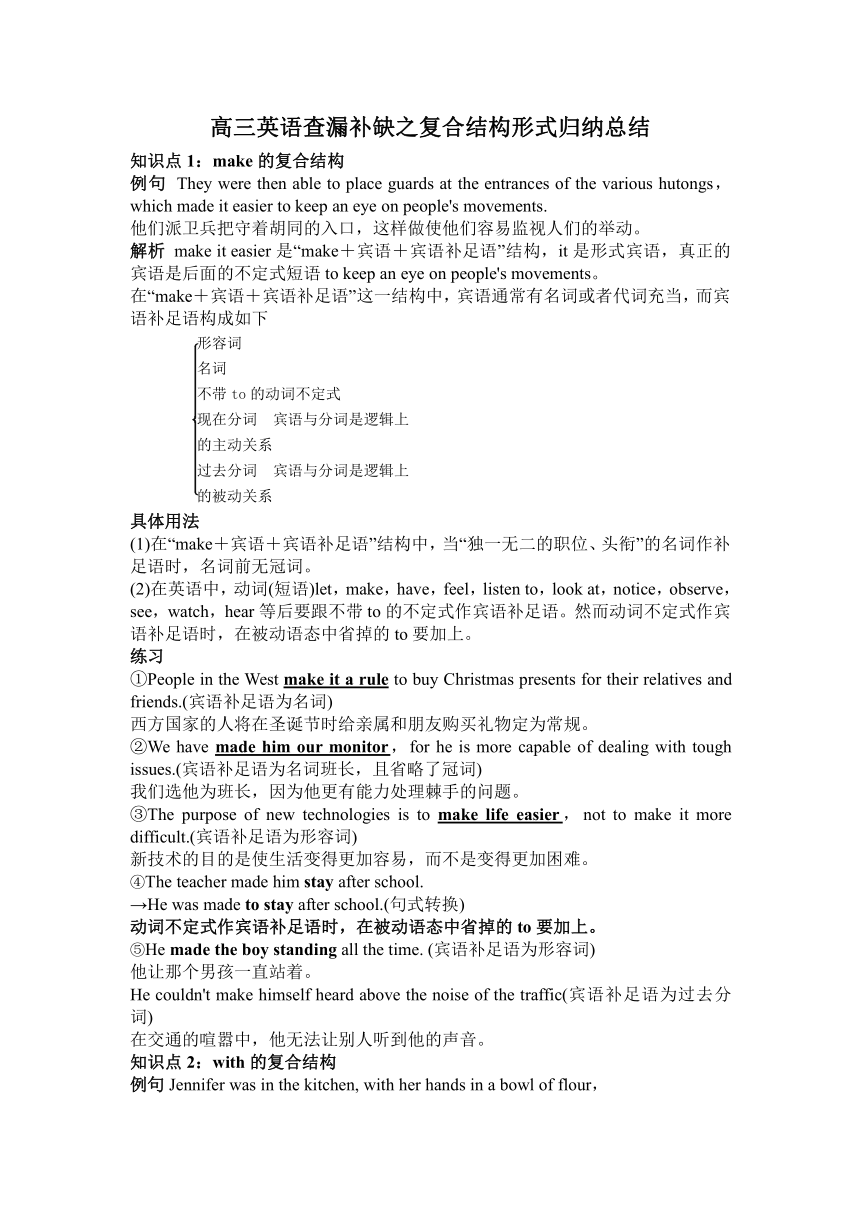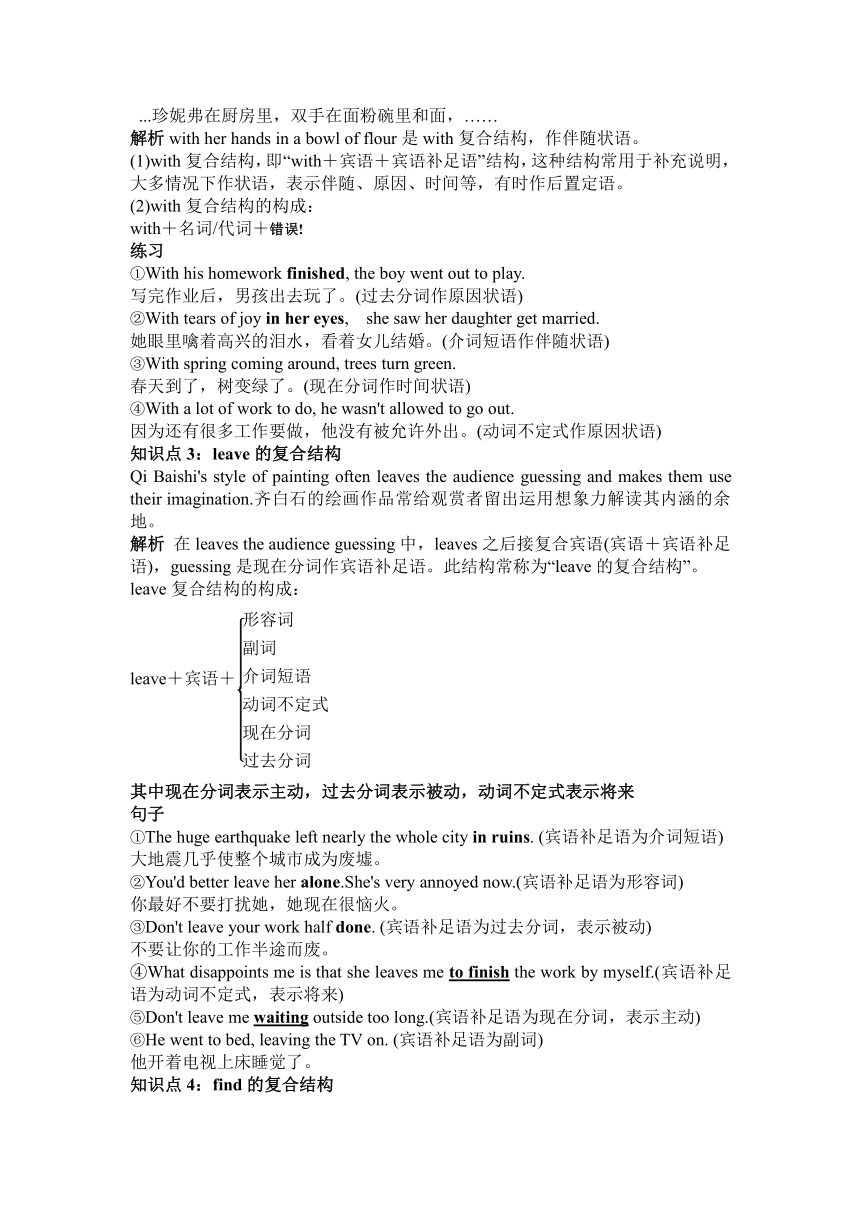2025届高三英语二轮复习复合结构形式归纳总结知识清单(讲义)
文档属性
| 名称 | 2025届高三英语二轮复习复合结构形式归纳总结知识清单(讲义) |  | |
| 格式 | docx | ||
| 文件大小 | 23.4KB | ||
| 资源类型 | 教案 | ||
| 版本资源 | 人教版(2019) | ||
| 科目 | 英语 | ||
| 更新时间 | 2025-02-22 16:45:29 | ||
图片预览


文档简介
高三英语查漏补缺之复合结构形式归纳总结
知识点1:make的复合结构
例句 They were then able to place guards at the entrances of the various hutongs,which made it easier to keep an eye on people's movements.
他们派卫兵把守着胡同的入口,这样做使他们容易监视人们的举动。
解析 make it easier是“make+宾语+宾语补足语”结构,it是形式宾语,真正的宾语是后面的不定式短语to keep an eye on people's movements。
在“make+宾语+宾语补足语”这一结构中,宾语通常有名词或者代词充当,而宾语补足语构成如下
具体用法
(1)在“make+宾语+宾语补足语”结构中,当“独一无二的职位、头衔”的名词作补足语时,名词前无冠词。
(2)在英语中,动词(短语)let,make,have,feel,listen to,look at,notice,observe,see,watch,hear等后要跟不带to的不定式作宾语补足语。然而动词不定式作宾语补足语时,在被动语态中省掉的to要加上。
练习
①People in the West make it a rule to buy Christmas presents for their relatives and friends.(宾语补足语为名词)
西方国家的人将在圣诞节时给亲属和朋友购买礼物定为常规。
②We have made him our monitor,for he is more capable of dealing with tough issues.(宾语补足语为名词班长,且省略了冠词)
我们选他为班长,因为他更有能力处理棘手的问题。
③The purpose of new technologies is to make life easier,not to make it more difficult.(宾语补足语为形容词)
新技术的目的是使生活变得更加容易,而不是变得更加困难。
④The teacher made him stay after school.
→He was made to stay after school.(句式转换)
动词不定式作宾语补足语时,在被动语态中省掉的to要加上。
⑤He made the boy standing all the time. (宾语补足语为形容词)
他让那个男孩一直站着。
He couldn't make himself heard above the noise of the traffic(宾语补足语为过去分词)
在交通的喧嚣中,他无法让别人听到他的声音。
知识点2:with的复合结构
例句Jennifer was in the kitchen, with her hands in a bowl of flour,
...珍妮弗在厨房里,双手在面粉碗里和面,……
解析with her hands in a bowl of flour是with复合结构,作伴随状语。
(1)with复合结构,即“with+宾语+宾语补足语”结构,这种结构常用于补充说明,大多情况下作状语,表示伴随、原因、时间等,有时作后置定语。
(2)with复合结构的构成:
with+名词/代词+
练习
①With his homework finished, the boy went out to play.
写完作业后,男孩出去玩了。(过去分词作原因状语)
②With tears of joy in her eyes, she saw her daughter get married.
她眼里噙着高兴的泪水,看着女儿结婚。(介词短语作伴随状语)
③With spring coming around, trees turn green.
春天到了,树变绿了。(现在分词作时间状语)
④With a lot of work to do, he wasn't allowed to go out.
因为还有很多工作要做,他没有被允许外出。(动词不定式作原因状语)
知识点3:leave的复合结构
Qi Baishi's style of painting often leaves the audience guessing and makes them use their imagination.齐白石的绘画作品常给观赏者留出运用想象力解读其内涵的余地。
解析 在leaves the audience guessing中,leaves之后接复合宾语(宾语+宾语补足语),guessing是现在分词作宾语补足语。此结构常称为“leave的复合结构”。
leave复合结构的构成:
leave+宾语+
其中现在分词表示主动,过去分词表示被动,动词不定式表示将来
句子
①The huge earthquake left nearly the whole city in ruins. (宾语补足语为介词短语)
大地震几乎使整个城市成为废墟。
②You'd better leave her alone.She's very annoyed now.(宾语补足语为形容词)
你最好不要打扰她,她现在很恼火。
③Don't leave your work half done. (宾语补足语为过去分词,表示被动)
不要让你的工作半途而废。
④What disappoints me is that she leaves me to finish the work by myself.(宾语补足语为动词不定式,表示将来)
⑤Don't leave me waiting outside too long.(宾语补足语为现在分词,表示主动)
⑥He went to bed, leaving the TV on. (宾语补足语为副词)
他开着电视上床睡觉了。
知识点4:find的复合结构
例句 He makes an attempt to eat it,but it is clear from the look on his face that he finds the taste truly disgusting.他试图吃它,但从他脸上的表情可以清楚地看出这个味道真的很令人讨厌。
解析 本句含“find+宾语+宾语补足语”结构。
“find+宾语+宾语补足语”结构形式归纳:
(1)find+宾语+
(2)find+it+形容词/名词+to do(it是形式宾语,to do是真正的宾语)
例句
①He found it difficult to work out the problem.
=He found the problem hard to work out.
②He found his book lying open on the desk.(宾语补足语为现在分词,表示主动)
③He opened the office and found much of his work finished.(宾语补足语为现在分词,表示完成)
④Did you find life hard in the country (宾语补足语为形容词)
⑤Nobody thinks it easy that one can pay off without outside help.
没有人认为不需要外力帮助就能轻易取得成功。
在复合宾语结构中,如果宾语过长,为了保持句子的平衡,常用形式宾语it代替,而把真正的宾语放在补语后边。其句型为:主语+find/think/believe/make/feel/consider...+it+宾语补足语(adj./n.)+真正的宾语(to do/that-clause)。
知识点5:have的复合结构
例句 This patient still had fresh scars from his first visit to us and this time he'd had both his legs blown off...这个病人还带着第一次在我们这里住院时留下的新伤疤,而这次他的双腿被炸掉了……
解析 have sth.done 表被动含义,意为“使某事被做”。
have的复合结构具体为
(1)have sth.done中过去分词作宾语补足语,表示被动的含义,有时也可用get sth.done来替换,该结构的意思是“使某事被做”,有时翻译成“请人做某事”或“主语遭遇到某事”。
(2)have sb.do...让某人做某事,have sb./sth.doing...让某人一直做某事/某事处于某种状态,用于否定句时have表示“容忍;容许”之意。
(3)have sth.to do...有事要做,have意为“有”。
例句
①The two men had the lights burning all night long.
②I have a composition to write,so I can't go out.
③Mother had me post the goods out.
④I had my watch repaired yesterday.
⑤I won't have you lying to your father.
知识点6:see的复合结构
例句I saw a black mass disappearing in the east.
我看到一大块黑东西在东方渐渐消失了。
解析 感官动词see, watch, observe, hear, notice等的宾补有以下形式(以see为例):
①see sb do sth 看见某人做了某事
②see sb doing sth 看见某人正在做某事
③see sb/sth done 看见某人/某物被……
④see sb/sth being done 看见某人/某物正在被……
(3)see sb do sth的被动结构为:sb be seen to do sth。
例句
①The thief was seen entering the building at that moment.
②I often see the boy blamed by his father for his carelessness.
③一句多译 我看见他几分钟前离开了。
I saw him leave a few minutes ago.(主动语态)
=He was seen to leave a few minutes ago(by me).(被动语态)
知识点1:make的复合结构
例句 They were then able to place guards at the entrances of the various hutongs,which made it easier to keep an eye on people's movements.
他们派卫兵把守着胡同的入口,这样做使他们容易监视人们的举动。
解析 make it easier是“make+宾语+宾语补足语”结构,it是形式宾语,真正的宾语是后面的不定式短语to keep an eye on people's movements。
在“make+宾语+宾语补足语”这一结构中,宾语通常有名词或者代词充当,而宾语补足语构成如下
具体用法
(1)在“make+宾语+宾语补足语”结构中,当“独一无二的职位、头衔”的名词作补足语时,名词前无冠词。
(2)在英语中,动词(短语)let,make,have,feel,listen to,look at,notice,observe,see,watch,hear等后要跟不带to的不定式作宾语补足语。然而动词不定式作宾语补足语时,在被动语态中省掉的to要加上。
练习
①People in the West make it a rule to buy Christmas presents for their relatives and friends.(宾语补足语为名词)
西方国家的人将在圣诞节时给亲属和朋友购买礼物定为常规。
②We have made him our monitor,for he is more capable of dealing with tough issues.(宾语补足语为名词班长,且省略了冠词)
我们选他为班长,因为他更有能力处理棘手的问题。
③The purpose of new technologies is to make life easier,not to make it more difficult.(宾语补足语为形容词)
新技术的目的是使生活变得更加容易,而不是变得更加困难。
④The teacher made him stay after school.
→He was made to stay after school.(句式转换)
动词不定式作宾语补足语时,在被动语态中省掉的to要加上。
⑤He made the boy standing all the time. (宾语补足语为形容词)
他让那个男孩一直站着。
He couldn't make himself heard above the noise of the traffic(宾语补足语为过去分词)
在交通的喧嚣中,他无法让别人听到他的声音。
知识点2:with的复合结构
例句Jennifer was in the kitchen, with her hands in a bowl of flour,
...珍妮弗在厨房里,双手在面粉碗里和面,……
解析with her hands in a bowl of flour是with复合结构,作伴随状语。
(1)with复合结构,即“with+宾语+宾语补足语”结构,这种结构常用于补充说明,大多情况下作状语,表示伴随、原因、时间等,有时作后置定语。
(2)with复合结构的构成:
with+名词/代词+
练习
①With his homework finished, the boy went out to play.
写完作业后,男孩出去玩了。(过去分词作原因状语)
②With tears of joy in her eyes, she saw her daughter get married.
她眼里噙着高兴的泪水,看着女儿结婚。(介词短语作伴随状语)
③With spring coming around, trees turn green.
春天到了,树变绿了。(现在分词作时间状语)
④With a lot of work to do, he wasn't allowed to go out.
因为还有很多工作要做,他没有被允许外出。(动词不定式作原因状语)
知识点3:leave的复合结构
Qi Baishi's style of painting often leaves the audience guessing and makes them use their imagination.齐白石的绘画作品常给观赏者留出运用想象力解读其内涵的余地。
解析 在leaves the audience guessing中,leaves之后接复合宾语(宾语+宾语补足语),guessing是现在分词作宾语补足语。此结构常称为“leave的复合结构”。
leave复合结构的构成:
leave+宾语+
其中现在分词表示主动,过去分词表示被动,动词不定式表示将来
句子
①The huge earthquake left nearly the whole city in ruins. (宾语补足语为介词短语)
大地震几乎使整个城市成为废墟。
②You'd better leave her alone.She's very annoyed now.(宾语补足语为形容词)
你最好不要打扰她,她现在很恼火。
③Don't leave your work half done. (宾语补足语为过去分词,表示被动)
不要让你的工作半途而废。
④What disappoints me is that she leaves me to finish the work by myself.(宾语补足语为动词不定式,表示将来)
⑤Don't leave me waiting outside too long.(宾语补足语为现在分词,表示主动)
⑥He went to bed, leaving the TV on. (宾语补足语为副词)
他开着电视上床睡觉了。
知识点4:find的复合结构
例句 He makes an attempt to eat it,but it is clear from the look on his face that he finds the taste truly disgusting.他试图吃它,但从他脸上的表情可以清楚地看出这个味道真的很令人讨厌。
解析 本句含“find+宾语+宾语补足语”结构。
“find+宾语+宾语补足语”结构形式归纳:
(1)find+宾语+
(2)find+it+形容词/名词+to do(it是形式宾语,to do是真正的宾语)
例句
①He found it difficult to work out the problem.
=He found the problem hard to work out.
②He found his book lying open on the desk.(宾语补足语为现在分词,表示主动)
③He opened the office and found much of his work finished.(宾语补足语为现在分词,表示完成)
④Did you find life hard in the country (宾语补足语为形容词)
⑤Nobody thinks it easy that one can pay off without outside help.
没有人认为不需要外力帮助就能轻易取得成功。
在复合宾语结构中,如果宾语过长,为了保持句子的平衡,常用形式宾语it代替,而把真正的宾语放在补语后边。其句型为:主语+find/think/believe/make/feel/consider...+it+宾语补足语(adj./n.)+真正的宾语(to do/that-clause)。
知识点5:have的复合结构
例句 This patient still had fresh scars from his first visit to us and this time he'd had both his legs blown off...这个病人还带着第一次在我们这里住院时留下的新伤疤,而这次他的双腿被炸掉了……
解析 have sth.done 表被动含义,意为“使某事被做”。
have的复合结构具体为
(1)have sth.done中过去分词作宾语补足语,表示被动的含义,有时也可用get sth.done来替换,该结构的意思是“使某事被做”,有时翻译成“请人做某事”或“主语遭遇到某事”。
(2)have sb.do...让某人做某事,have sb./sth.doing...让某人一直做某事/某事处于某种状态,用于否定句时have表示“容忍;容许”之意。
(3)have sth.to do...有事要做,have意为“有”。
例句
①The two men had the lights burning all night long.
②I have a composition to write,so I can't go out.
③Mother had me post the goods out.
④I had my watch repaired yesterday.
⑤I won't have you lying to your father.
知识点6:see的复合结构
例句I saw a black mass disappearing in the east.
我看到一大块黑东西在东方渐渐消失了。
解析 感官动词see, watch, observe, hear, notice等的宾补有以下形式(以see为例):
①see sb do sth 看见某人做了某事
②see sb doing sth 看见某人正在做某事
③see sb/sth done 看见某人/某物被……
④see sb/sth being done 看见某人/某物正在被……
(3)see sb do sth的被动结构为:sb be seen to do sth。
例句
①The thief was seen entering the building at that moment.
②I often see the boy blamed by his father for his carelessness.
③一句多译 我看见他几分钟前离开了。
I saw him leave a few minutes ago.(主动语态)
=He was seen to leave a few minutes ago(by me).(被动语态)
